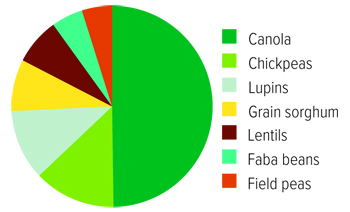Limiting the impact of disease on pulses and oilseeds requires an integrated approach.
Commonly used as break crops, oilseeds and pulses provide many rotational benefits to cereal crops and can also be highly profitable in their own right.
Figure 1: Canola and pulses are significant break crops that provide many rotational benefits to cereal crops and can be highly profitable. Five-year average area grown across Australia (2016/17 to 2020/21).
Source: ABARES
The most dominant of these, canola, is the third-largest crop produced in Australia, with about 2.5 million hectares grown each year (Figure 1).
Winter and summer pulses, combined, cover a similar area. Limiting the impact of disease is essential to maximise both the rotational benefit and profitability of these crops.
GRDC is targeting profitable disease management through surveillance and diagnostics, pathogen biology, epidemiology (how disease develops in the environment), genetic solutions and the development of integrated disease management packages.
Surveillance and accurate identification are key. Our investment in surveillance provides growers and advisers with intelligence on changes in pathogen population and distribution, virulence and new and emerging threats. It also enables market access by supporting ‘area freedom’ status.
Advances in DNA testing technology allow disease outbreaks to be detected before symptoms appear, enabling more targeted and timely fungicide application. For example, DNA testing of spores collected by the iMapPESTS sentinel can objectively and accurately track changes in populations to provide timely information on pathogen abundance.
These tools are particularly useful when studying viruses and have led to more accurate virus identification and, consequently, better understanding about how these viruses spread, which will improve how viruses are managed. Such technology also plays a crucial role in protecting our industries against new incursions through the quarantine testing of the imported germplasm required by our breeding programs.
Changing farming systems mean we are seeing changes in host–pathogen interaction. Canola is the perfect example: early sowing has led to the development of upper canopy infection, and stubble retention means spore release may coincide with the time when paddocks are rotated back into canola. Epidemiology and disease management research need to be revisited to ensure a robust understanding of how they interact under modern and future farming systems, including the effect of climatic variability.
Changes in pathogen virulence and the development of fungicide resistance highlight the need to continue to search for novel sources of genetic resistance to disease. To avoid the ‘boom-and-bust’ cycles that occur when new resistant varieties are released, GRDC is seeking to broaden its range of resistance genes and to develop markers to speed their progress into breeding programs. The genetic advances reported here include blackleg and Sclerotinia in canola and Ascochyta in chickpeas.
To bring it all together for you, GRDC is actively investing in local disease experts who understand their region’s agronomic situation and can provide diagnostic services and tailor integrated disease management advice to meet the needs of growers and advisers. One example is the recent update of pulse disease resistance categories to better align with management strategies.
More information: Dr Friday Obanor, 02 6166 4530, friday.obanor@grdc.com.au

























































